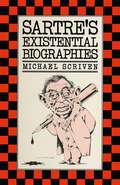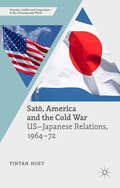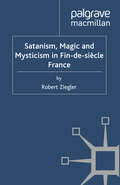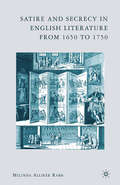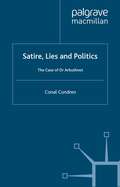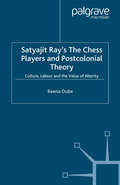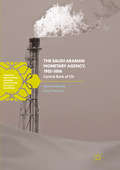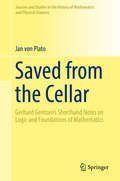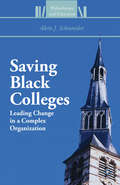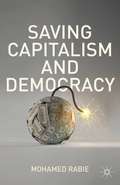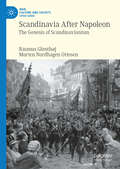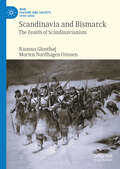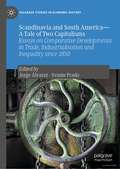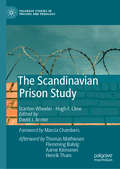- Table View
- List View
Sartre in Cuba–Cuba in Sartre
by William RowlandsonThis book explores Sartre’s engagement with the Cuban Revolution. In early 1960 Jean-Paul Sartre and Simone de Beauvoir accepted the invitation to visit Cuba and to report on the revolution. They arrived during the carnival in a land bursting with revolutionary activity. They visited Che Guevara, head of the National Bank. They toured the island with Fidel Castro. They met ministers, journalists, students, writers, artists, dockers and agricultural workers. Sartre spoke at the University of Havana. Sartre later published his Cuba reports in France-Soir. Sartre endorsed the Cuban Revolution. He made clear his political identification. He opposed colonialism. He saw the US as colonial in Cuban affairs from 1898. He supported Fidel Castro. He supported the agrarian reform. He supported the revolution. His Cuba accounts have been maligned, ignored and understudied. They have been denounced as blind praise of Castro, ‘unabashed propaganda.’ They have been criticised for ‘clichés,’ ‘panegyric’ and ‘analytical superficiality.’ They have been called ‘crazy’ and ‘incomprehensible.’ Sartre was called naïve. He was rebuked as a fellow traveller. He was, in the words of Cuban author Guillermo Cabrera Infante, duped by ‘Chic Guevara.’ This book explores these accusations. Were Sartre’s Cuba texts propaganda? Are they blind praise? Was he naïve? Had he been deceived by Castro? Had he deceived his readers? Was he obligated to Castro or to the Revolution? He later buried the reports, and abandoned a separate Cuba book. His relationship with Castro later turned sour. What is the impact of Cuba on Sartre and of Sartre on Cuba?
Sartre on the Body (Philosophers in Depth)
by K. MorrisSartre scholars and others engage with Jean-Paul Sartre's descriptions of the human body, bringing him into dialogue with feminists, sociologists, psychologists and historians and asking: What is pain? Do men and women experience their bodies differently? How do society and culture shape our bodies? Can we re-shape them?
Satō, America and the Cold War: US-Japanese Relations, 1964–72 (Security, Conflict and Cooperation in the Contemporary World)
by Fintan HoeyUsing recently released archival material from the US and Japan, this book critically re-examines US–Japanese relations during the tenure of Satō Eisaku, Japan’s longest serving prime minister. During these critical years in the Cold War in Asia, with the Vietnam War raging and the acquisition by China of a nuclear capability, Satō closely aligned with the US. This directly contributed to his success in securing the reversion of Okinawa and other Japanese territories which had remained under US control since Japan’s surrender at the end of World War II. To accomplish this he was also forced to conclude secret agreements with President Richard Nixon, including one on nuclear weapons, which are explored fully. Satō faced the challenge of the Nixon administration’s attempts to shore up the relative decline in American power with policies at odds with allied interests. Satō successfully overcame such challenges and also laid the groundwork for Japan’s anti-nuclear policy.
Satanism, Magic and Mysticism in Fin-de-siècle France (Palgrave Historical Studies in Witchcraft and Magic)
by R. ZieglerAn interdisciplinary study of the supernatural and the occult in fin-de-siècle France (1870-1914), the present volume examines the explosion of interest in devil-worship, magic and mysticism both from an historical perspective and through analysis of key literary works of the period.
Satire and Romanticism
by S. JonesThis remarkable study of the constructive and ultimately canon-forming relationship between satiric and Romantic modes of writing from 1760 to 1832 provides us with a new understanding of the historical development of Romanticism as a literary movement. Romantic poetry is conventionally seen as inward-turning, sentimental, sublime, and transcendent, whereas satire, with its public, profane, and topical rhetoric, is commonly cast in the role of generic other as the un-Romantic mode. This book argues instead that the two modes mutually defined each other and were subtly interwoven during the Romantic period. By rearranging reputations, changing aesthetic assumptions, and re-distributing cultural capital, the interaction of satiric and Romantic modes helped make possible the Victorian and modern construction of 'English Romanticism'.
Satire and Secrecy in English Literature from 1650 to 1750
by M. RabbThis book revises assumptions about satire as a public, masculine discourse derived from classical precedents, in order to develop theoretical and critical paradigms that accommodate women, popular culture, and postmodern theories of language as a potentially aggressive, injurious act. Although Habermas places satirists like Swift and Pope in the public sphere, this book investigates their participation in clandestine strategies of attack in a world understood to be harboring dangerous secrets. Authors of anonymous pamphlets as well as major figures including Behn, Dryden, Manley, Swift, and Pope, share at times what Swift called the writer's "life by stealth."
Satire, Lies and Politics: The Case of Dr Arbuthnot
by C. CondrenThis, the first full analysis of Arbuthnot's Art of Political Lying (1712), argues that the work is a commentary on long-standing themes of debate in science, rhetoric and philosophy and should be seen as a seminal satire standing in opposition to the practice of Swift and Pope. Rather than simply condemning dishonesty, Arbuthnot raises serious questions about the elusive nature of truth in politics. The argument thus traverses literary analysis, intellectual history and philosophy. An original version of the Art of Political Lying , based on English and French editions is supplied in the appendix.
The Satisfaction of Change: How Knowledge and Innovation Overcome Loyalty in Decision-Making Processes
by Manlio Del Giudice Maria Rosaria Della PerutaThis book analyzes the impact of the digital economy on customer satisfaction, shopping experience, resistance to change, script theory, and loyalty. The model introduced assumes that online markets have led to a redefinition of the concepts of loyalty and shopping scripts as a way to reduce customers’ cognitive effort, by optimizing purchase time and increasing the speed and satisfaction of the shopping experience. It describes the utility function of the script by retaining customer loyalty and making the customer more reluctant to abandon his regular supplier. It also explores the difficulty faced by the higher churn rate on the Internet and the minimization of search costs, by integrating more functionality to achieve the ultimate goal of behavioral and cognitive loyalty.The authors provide an analysis in a "digital" view of the economic theory of switching costs and the resulting lock-in mechanisms which, in a classical economy, are often a barrier to disloyalty. It is a useful and effective tool for online businesses, their main managerial and strategic implications, and the adaptability to existing contexts.
The Satisfaction of Change: How Knowledge and Innovation Overcome Loyalty in Decision-Making Processes
by Manlio Del Giudice Maria Rosaria Della PerutaThis book analyzes the impact of the digital economy on customer satisfaction, shopping experience, resistance to change, script theory, and loyalty. The model introduced assumes that online markets have led to a redefinition of the concepts of loyalty and shopping scripts as a way to reduce customers’ cognitive effort, by optimizing purchase time and increasing the speed and satisfaction of the shopping experience. It describes the utility function of the script by retaining customer loyalty and making the customer more reluctant to abandon his regular supplier. It also explores the difficulty faced by the higher churn rate on the Internet and the minimization of search costs, by integrating more functionality to achieve the ultimate goal of behavioral and cognitive loyalty.The authors provide an analysis in a "digital" view of the economic theory of switching costs and the resulting lock-in mechanisms which, in a classical economy, are often a barrier to disloyalty. It is a useful and effective tool for online businesses, their main managerial and strategic implications, and the adaptability to existing contexts.
Saturday Night Live, Hollywood Comedy, and American Culture: From Chevy Chase to Tina Fey
by J. WhalleySaturday Night Live, Hollywood Comedy, and American Culture sheds new light on the ways in which Saturday Night Live s confrontational, boundary-pushing approach spilled over into film production, contributing to some of the biggest hits in Hollywood history, such as National Lampoon s Animal House, Ghostbusters, and Beverly Hills Cop. Jim Whalley also considers how SNL has adapted to meet the needs of subsequent generations, launching the film careers of Mike Myers, Adam Sandler, Will Ferrell and others in the process. Supported by extensive archival research, some of Hollywood s most popular comedians are placed into the contexts of film and television comic traditions and social and cultural trends in American life.
Satyajit Ray's The Chess Players and Postcolonial Film Theory: Postcolonialism and Film Theory (Language, Discourse, Society)
by Reena DubeIndispensable for students of film studies, in this book Reena Dube explores Satyajit Ray's films, and The Chess Players in particular, in the context of discourses of labour in colonial and postcolonial conditions. Starting from Daniel Defoe and moving through history, short story and film to the present, Dube widens her analysis with comparisons in which Indian films are situated alongside Hollywood and other films, and interweaves historical and cultural debates within film theory. Her book treats film as part of the larger cultural production of India and provides a historical sense of the cross genre borrowings, traditions and debates that have deeply influenced Indian cinema and its viewers.
Saudi Arabia: The Shape of a Client Feudalism
by Geoff SimonsSimons describes the current human-rights situation in Saudi Arabia with reference to corruption, the treatment of dissidents, the penal system, the suppression of women, slavery and other aspects. A detailed history, from pre-Islamic times to the present, is provided, with attention to the influence of Mohammed, the Saudi ascendancy, the role of the West, the discovery of oil and the wars in the region. Finally attention is given to the various (economic/political/religious) problems that today face the Saudi regime and to the Saudi response.
The Saudi Arabian Monetary Agency, 1952-2016: Central Bank of Oil
by Ahmed Banafe Rory MacleodThis book sheds new light on the critical importance of the Saudi Arabian Monetary Agency (SAMA), a remarkably successful central bank that is a model for developing oil exporters worldwide. As a "swing producer", Saudi Arabia has traditionally stepped in to make up for oil supply shortfalls in other OPEC countries, or to scale back their own production when overabundance might lead to a price crash. Since 2014, Saudi Arabia has changed its policy in response to the rise of American shale oil, in search of a long-term strategy that will, once again, help balance supply and demand at a steady price. In its informal dual role of central bank and sovereign wealth fund, SAMA must navigate the paradoxes faced by monoline oil producing countries: the need for diversification vs. dependence on oil-based revenue; the loss of foreign exchange reserves that follows oil-financed government spending; the unreliability of revenue from oil; the challenges of using a Western model for supervising Shariah-compliant banks; and the need to have a balancing mix of oil and financial assets. As SAMA (now the Saudi Arabian Monetary Authority) reassesses its role in 2017, this history and guide to current policy issues will prove invaluable for policymakers in oil producing economies looking to apply lessons from the past as they plan for the future.
The Saudi Arabian Monetary Agency, 1952-2016: Central Bank of Oil
by Ahmed Banafe Rory MacleodThis book sheds new light on the critical importance of the Saudi Arabian Monetary Agency (SAMA), a remarkably successful central bank that is a model for developing oil exporters worldwide. As a "swing producer", Saudi Arabia has traditionally stepped in to make up for oil supply shortfalls in other OPEC countries, or to scale back their own production when overabundance might lead to a price crash. Since 2014, Saudi Arabia has changed its policy in response to the rise of American shale oil, in search of a long-term strategy that will, once again, help balance supply and demand at a steady price. In its informal dual role of central bank and sovereign wealth fund, SAMA must navigate the paradoxes faced by monoline oil producing countries: the need for diversification vs. dependence on oil-based revenue; the loss of foreign exchange reserves that follows oil-financed government spending; the unreliability of revenue from oil; the challenges of using a Western model for supervising Shariah-compliant banks; and the need to have a balancing mix of oil and financial assets. As SAMA (now the Saudi Arabian Monetary Authority) reassesses its role in 2017, this history and guide to current policy issues will prove invaluable for policymakers in oil producing economies looking to apply lessons from the past as they plan for the future.
The Savage Wars of Peace: England, Japan and the Malthusian Trap
by A. MacfarlaneThis book aims to solve the problem of how parts of mankind escaped from an apparently inevitable trap of war, famine and disease in the last three hundred years. Through a detailed comparative analysis of English and Japanese history it explores such matters as the destruction of war, decline of famine, importance of certain drinks (especially tea), the use of human excrement and the effects of housing, clothing and bathing on human health. It also shows how the English and Japanese controlled fertility through marriage and sexual patterns, biological and contraceptive factors, abortion and infanticide.
Saved from the Cellar: Gerhard Gentzen’s Shorthand Notes on Logic and Foundations of Mathematics (Sources and Studies in the History of Mathematics and Physical Sciences)
by Jan Von PlatoGerhard Gentzen is best known for his development of the proof systems of natural deduction and sequent calculus, central in many areas of logic and computer science today. Another noteworthy achievement is his resolution of the embarrassing situation created by Gödel's incompleteness results, especially the second one about the unprovability of consistency of elementary arithmetic. After these successes, Gentzen dedicated the rest of his short life to the main problem of Hilbert's proof theory, the question of the consistency of analysis. He was arrested in the summer of 1945 with other professors of the German University of Prague and died soon afterward of starvation in a prison cell. Attempts at locating his lost manuscripts failed at the time, but several decades later, two slim folders of shorthand notes were found. In this volume, Jan von Plato gives an overview of Gentzen's life and scientific achievements, based on detailed archival and systematic studies, and essential for placing the translations of shorthand manuscripts that follow in the right setting. The materials in this book are singular in the way they show the birth and development of Gentzen's central ideas and results, sometimes in a well-developed form, and other times as flashes into the anatomy of the workings of a unique mind.
Saving Black Colleges: Leading Change in a Complex Organization (Philanthropy and Education)
by Alvin J. SchexniderSaving Black Colleges makes clear the challenges, opportunities, and prospects for change historically black colleges and universities now face. Schexnider, the former chancellor of Winston-Salem State University, details what he could and could not accomplish, examines how these issues affect other HBCUs, and outlines a practical way forward.Alvin J. Schexnider is the president of Schexnider & Associates, LLC. He previously served as the president of Thomas Nelson Community College and as the executive vice president and interim president of Norfolk State University.
Saving Capitalism and Democracy
by M. RabieSaving Capitalism and Democracy tries to answer the difficult questions posed by intellectuals, the media, politicians, students and ordinary people concerning the crisis and how to avert an impending catastrophe.
Scandinavia After Napoleon: The Genesis of Scandinavianism (War, Culture and Society, 1750–1850)
by Rasmus Glenthøj Morten Nordhagen OttosenThis book explores the intellectual grounds of Scandinavianist ideology and its political development into a national unification movement. Denmark, Norway and Sweden were nearly annihilated during the Napoleonic Wars. The lesson learned was that survival was a matter of size. Whereas their union of 1814 offered Sweden-Norway geostrategic security tempered by fear of Russia, Denmark was the biggest territorial loser of the Napoleonic Wars and faced separatism connected to German nationalism in the duchies of Schleswig and Holstein. This evolved into a national conflict that threatened Denmark’s survival as a nation. Meanwhile, a new generation of Danes, Swedes and Norwegians had come to regard kindred language, culture and religion as a case for Scandinavian union that could offer protection against Russia and Germany. When the European revolutions of 1848 unleashed the First Schleswig War, the influence of Scandinavianism was such that it nearly turned into a Scandinavian war of unification.
Scandinavia and Bismarck: The Zenith of Scandinavianism (War, Culture and Society, 1750–1850)
by Rasmus Glenthøj Morten Nordhagen OttosenThis book accounts for Scandinavian unification efforts in a time of great upheaval. The ideological repercussions of the European revolutions of 1848-1849 and the Crimean War (1853-1856) transformed both the international political system and nationalism into more ‘realist’ types. The First Schleswig War (1848-1851) having nearly turned into one of Scandinavian unification, the influence of Scandinavianism extended into the Danish, Swedish and Norwegian courts, cabinets and parliaments, attracting interest from the great powers. The Crimean War offered another window of opportunity for Scandinavian unification, before the Danish-German conflict over the duchies of Schleswig and Holstein nearly united Scandinavia upon the outbreak of the Second Schleswig War in 1864. The ultimate failure of Scandinavianism in its unification efforts was not predetermined, although historiography has made it appear as such. Napoleon III, Cavour and Bismarck all actively contributed to plans for Scandinavian unification, the latter even declaring himself as “very strongly Scandinavian”.
Scandinavia and South America—A Tale of Two Capitalisms: Essays on Comparative Developments in Trade, Industrialisation and Inequality since 1850 (Palgrave Studies in Economic History)
by Jorge Álvarez Svante PradoThis book takes a comparative approach to economic history to offer ways to increase our understanding of the divergence between South America and Scandinavia. In particular, the book aims to deepen our understanding of why the two groups of countries have set out on radically different pathways with regard to industrialisation, long-term economic growth and income distribution. The book draws together the results of two separate projects focusing on this comparison. The first of these projects focuses on two of the so-called settler societies of South America, namely Uruguay and Argentina, sometimes called the Pampas region. Australia and New Zealand, two other settler societies, are also considered, adding a further contrasting effect. These settler societies are compared with Scandinavia, in its broad terms, including Sweden, Denmark, Norway and Finland. The second of these projects focuses on comparisons between Brazil and Sweden. Together, the two projects have engaged the minds of economic historians from Brazil, Uruguay and Sweden. This book will be of interest to researchers and students in economic history and economic development more broadly.
The Scandinavian Prison Study (Palgrave Studies in Prisons and Penology)
by Stanton Wheeler Hugh F. ClineThis book presents the formerly-unpublished manuscript by Wheeler and Cline detailing the landmark, comparative prisons study they conducted in the 1960s which examined fifteen Scandinavian prisons and nearly 2000 inmates across four Nordic countries. At the time, it was the largest comparative study of prisons and inmate behavior ever undertaken and despite 15 years of analysis and write-up it was never published but it influenced many other important prison studies that followed. This book engages with the functionalist perspectives that were widespread in the 1960s, and tries to answer some of the classical questions of prison sociology such as how prisoners adapt to imprisonment and the degree to which prisoner adaptations can be attributed to characteristics of prisoners and prisons. It examines the nature and structure of prisons, the effect of that structure on individual prisoners and the other factors that may influence the way that they respond to confinement. It also includes discussion about the prisoners’ considerations of justice and fairness and a explanation of the study design and data which was highly unique at the time. The Scandinavian Prison Study brings Wheeler and Cline's pioneering work into the present context with a preface and an introduction which discuss the questions and claims raised in the book still relevant to this day.


